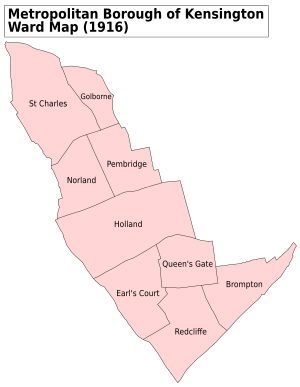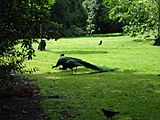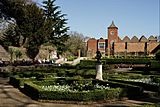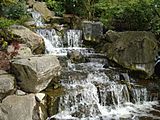Holland Park facts for kids
Quick facts for kids Holland Park |
|
|---|---|
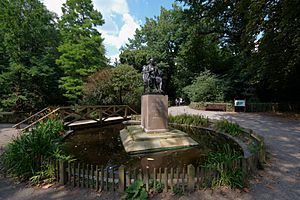 Statue of the 3rd Baron Holland in Holland Park |
|
| OS grid reference | TQ246798 |
| London borough | |
| Ceremonial county | Greater London |
| Region | |
| Country | England |
| Sovereign state | United Kingdom |
| Post town | LONDON |
| Postcode district | W8, W11, W14 |
| Dialling code | 020 |
| Police | Metropolitan |
| Fire | London |
| Ambulance | London |
| EU Parliament | London |
| UK Parliament | |
| London Assembly | |
Holland Park is a beautiful area in Kensington, West Central London. It has a famous street and a large public park, both named Holland Park. This area doesn't have exact borders. But it's generally found between Kensington High Street to the south and Holland Park Avenue to the north. To the west is Holland Road, and to the east is Kensington Church Street. Nearby areas include Notting Hill to the north and Earl's Court to the south.
Holland Park is known for its tree-lined streets. You'll find many large Victorian townhouses here. The area also has lots of shops, cool places like the Design Museum, and nice hotels and restaurants. Several countries even have their embassies here. The street called Holland Park was built between 1860 and 1880. Builders William and Francis Radford created over 200 houses in this area. Famous old buildings include the Royal Crescent and Aubrey House.
Discovering Holland Park's Past
Before the 1800s, this area was mostly countryside. Most of what we now call Holland Park used to be the grounds of a big house. This house was a Jacobean mansion called Holland House.
Later in the 1800s, the owners of Holland House started selling off parts of their land. This land was then used to build homes. The new area that grew up around the house took its name from it. Some smaller parts of the area, like the Phillimore Estate, were never part of Holland House's grounds.
In the late 1800s, many famous artists lived here. These included Frederic Leighton and Valentine Cameron Prinsep. They were part of a group known as the Holland Park Circle. Many art collectors also lived in this creative neighborhood.
Exploring the Public Park
- Holland Park
Holland Park covers about 22 hectares (54 acres). The northern part has wild woodlands. The middle section has beautiful formal gardens. The southern part is used for sports.
Holland House was badly damaged during the Second World War in 1940. It was hit by bombs. In 1952, the London County Council bought the ruins and the park grounds. Today, the remains of the house are a backdrop for the Holland Park Theatre. This theatre is home to Opera Holland Park. South of the park is the Design Museum.
The park has a café and the Belvedere Restaurant. There's also a giant chess set and a cricket pitch. You can play tennis on the courts. The park is home to two Japanese gardens: the Kyoto Garden (opened in 1991) and the Fukushima Memorial Garden (opened in 2012). There's also a youth hostel and a children's playground. You'll often see squirrels and peacocks roaming around.
In 2010, a part of the park was set aside for pigs. Their job was to clear out nettles and other plants. This helped create a new meadow for wild flowers and animals. Later, cattle were used for a similar purpose.
The Holland Park Ecology Centre opened in 2013. It offers programs about nature and the environment. You can join nature walks, talks, and outdoor activities for kids. Schools also have special programs here.
See also
 In Spanish: Holland Park para niños
In Spanish: Holland Park para niños



